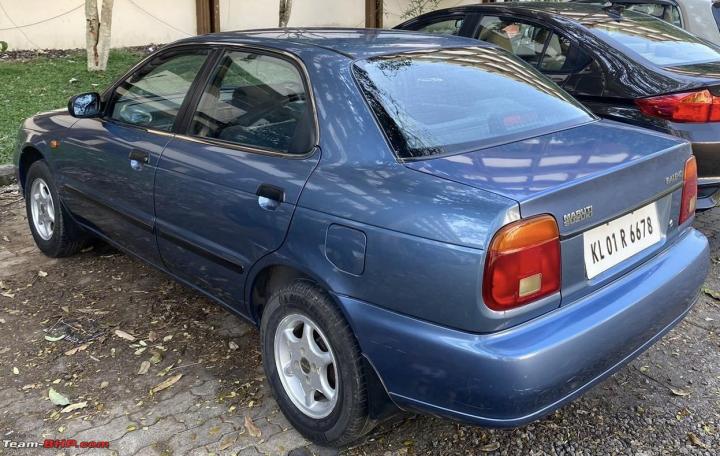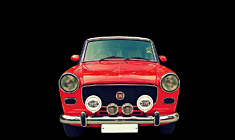News
VW Virtus fuel economy in city, ghats & expressways: Owner's insights
The city fuel efficiency of my VW Virtus 1.0L automatic usually falls in the 8-10 kmpl range. This is with the air conditioning on.
BHPian supernova105 recently shared this with other enthusiasts:
I would like to share a few mileage figures achieved on a short weekend drive for breakfast towards Yavat on Solapur Road for my 1.0 AT.
This was with hardly 10% AC On, and occasional few bursts of hard acceleration upto 100/110.

The below image includes the return trip with the AC on 22/23 full time.

This is mostly because of the weekend and very sparse traffic.
I visited Sai Krupa Tea House, which is famous for its Misal, Bhel, and South Indian fare.
I had a cut dosa and their special Kadak Chai (their normal chai is very milky but a perfect blend of masala which I had when I last visited this place)
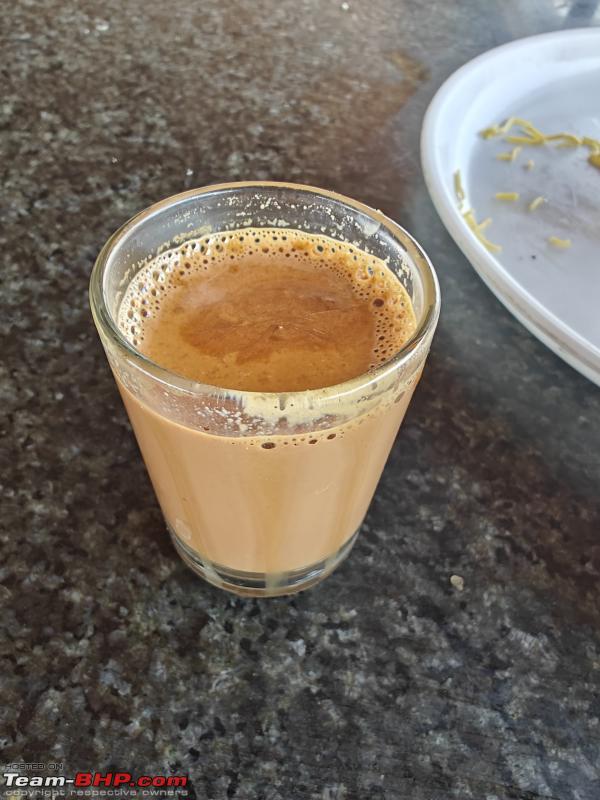

My maiden drive on the expressway while returning from Ghodbunder Road, Thane to Pune yielded around 14.5 KMPL with AC on 70% of the time, which includes the infamous traffic-laden Ghats and weekend traffic in both cities, which is a good number.
City figures usually range from 8-10KM/L with AC On, and if it's moving traffic in Pune, it gives 11-12.
Drive to Mulkhed Point
Sharing a few pictures of a short drive last weekend towards Mulkhed Point ahead of Sus Road towards Pirangut (Also called Mini Necklace Point since it bears resemblance to the original Necklace Point near Bhor).




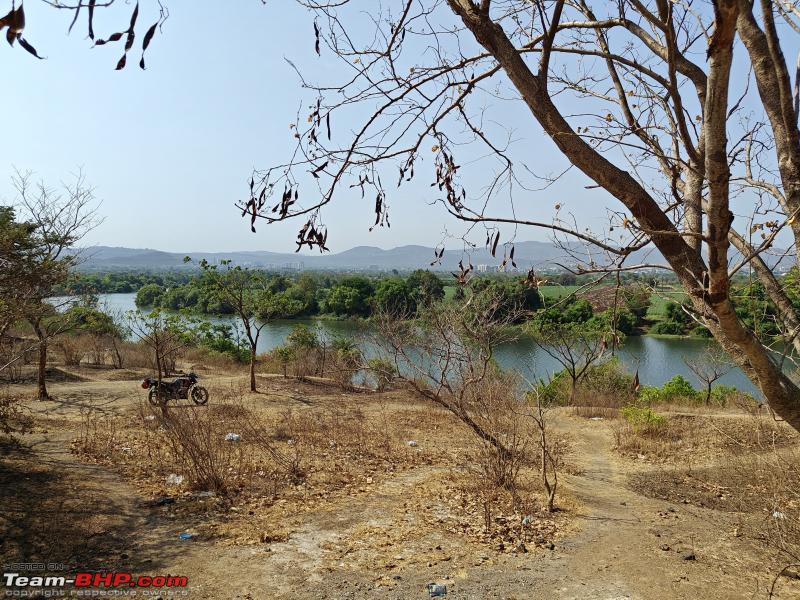


Check out BHPian comments for more insights and information.
News
Loved, not just used: Preserving our 25-year-old Maruti Baleno sedan
The car is still a delight to drive. The 1.6L G16B engine remains refined and strong, offering excellent low-end torque and smooth cruising ability.
BHPian Armaan Sait recently shared this with other enthusiasts:
Hello Team-BHP,
Iâm excited to finally share something close to my heart: our 2000 Maruti Baleno, finished in the rare Atlantic Blue shade. Itâs been a part of our family since new, and even today, it continues to turn heads with its classic charm and preserved condition.

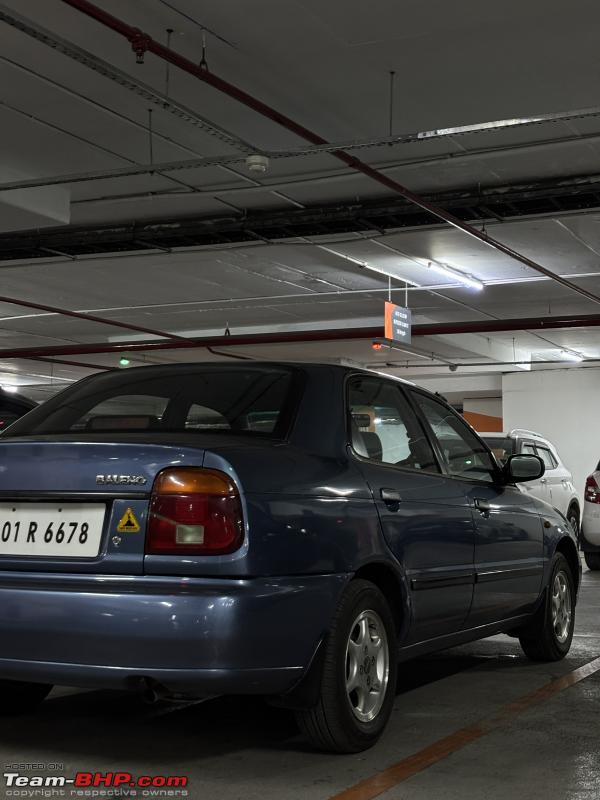

Background:
- Year of manufacture: 2000
- Colour: Aquatic Blue (rare shade, barely seen now)
- Odometer reading: 128,000 km
- Usage: Light and careful usage throughout its life, always parked under shade.
- Ownership: Single-family owned from day one.
This car has been loved, not just used. Even after 24+ years, it retains its originality, soul, and smooth driving dynamics that made the Baleno special back in the day.

Condition & Maintenance:
- Paint: 100% original Aquatic Blue factory paint.
- Interior: Entirely stock â original fabric upholstery, dashboard, switchgear, and trim panels intact and in excellent shape.
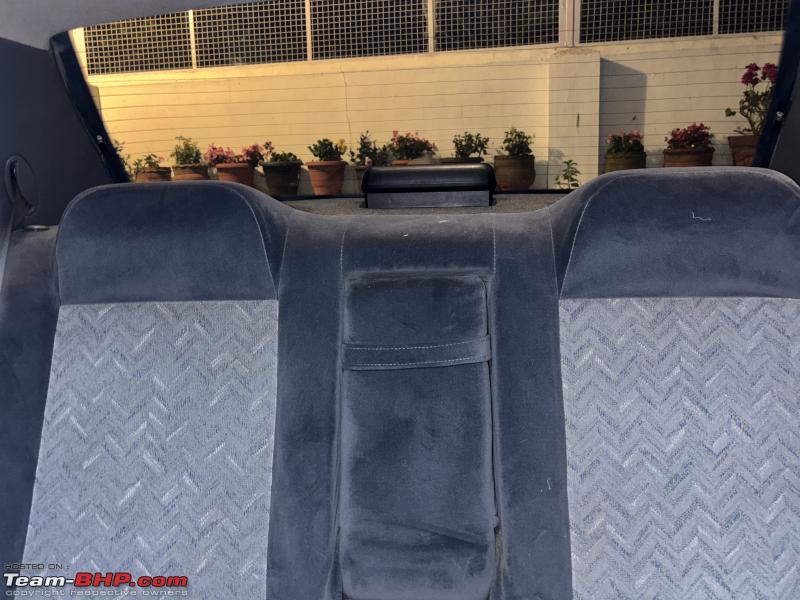

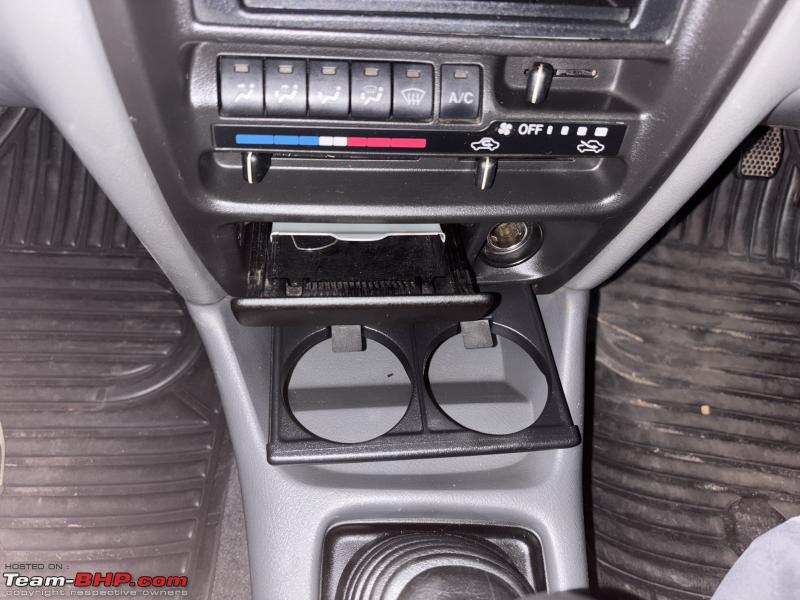

âą Mechanical: Regularly maintained with genuine parts; still drives like a dream.

âą Accessories: Still retains the original Kenwood KRC-485 cassette receiver that came factory-fitted (with manual, invoice, and packaging preserved).

Documents:
- Original Maruti ownerâs manual, service booklet.
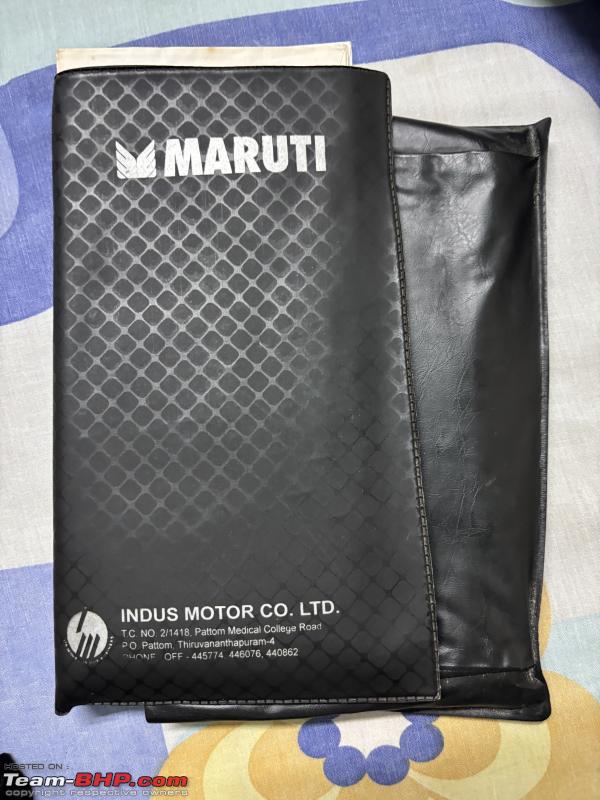


- Kenwood audio manual and warranty card.

- Original envelopes and documentation from Indus Motors.

- Period newspaper clippings preserved alongside.
Driving Experience:
The Baleno is still a delight to drive. The 1.6L G16B engine remains refined and strong, offering excellent low-end torque and smooth cruising ability. The hydraulic steering feels wonderfully communicative â a rarity today. Itâs comfortable on highways, composed around bends, and very easy to drive in the city even after all these years.
Why Itâs Special to Me:
In todayâs world of modern, tech-laden cars, the Baleno reminds me what true mechanical purity feels like. Itâs simple, reliable, soulful â and in this condition, an increasingly rare sight. Itâs not just a car; itâs a member of the family.
Weâve taken special care to retain its originality, and the documents, photos, and memories associated with it are just as cherished as the car itself.
Some of the Old Pics taken of the Baleno:

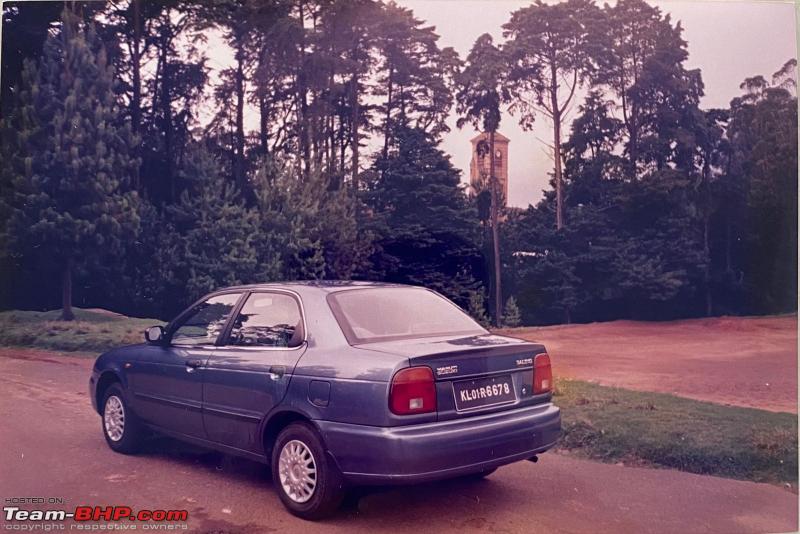

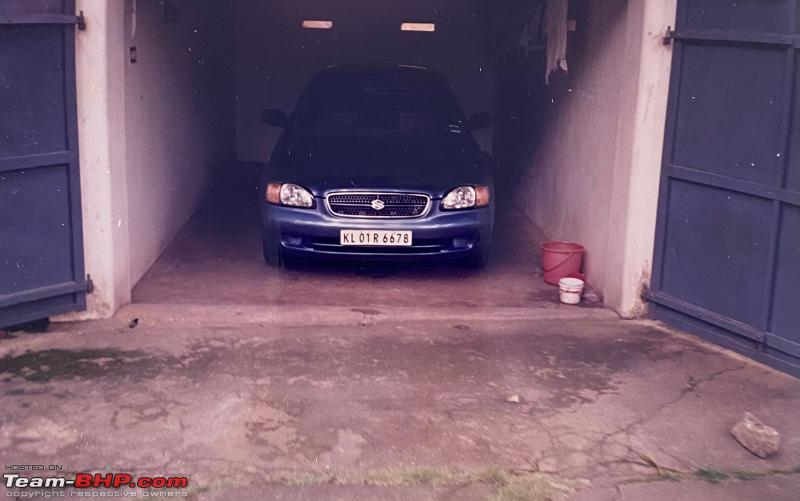
Plans Going Forward:
The goal is simple â keep it running, keep it original, and preserve it as a time capsule for as long as possible. Every drive is special, and every glance at it brings back memories.
Thank you, Team-BHP, for providing a platform where enthusiasts understand the joy of preserving a classic like this.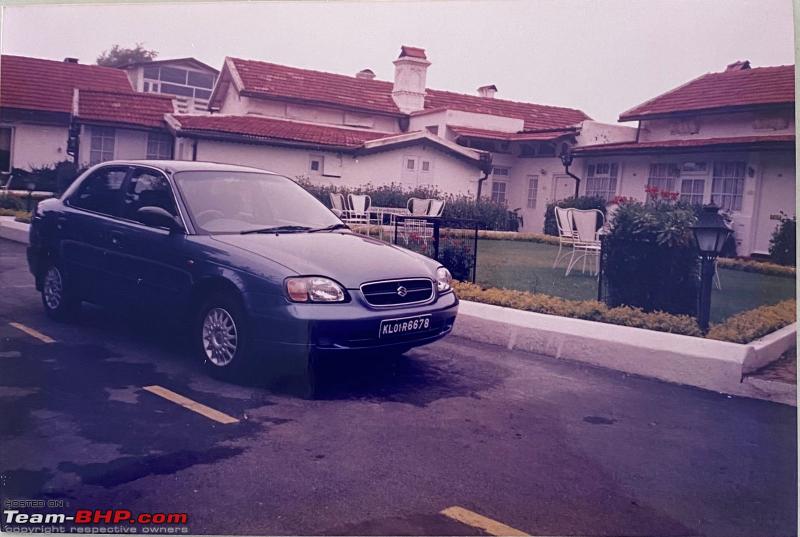
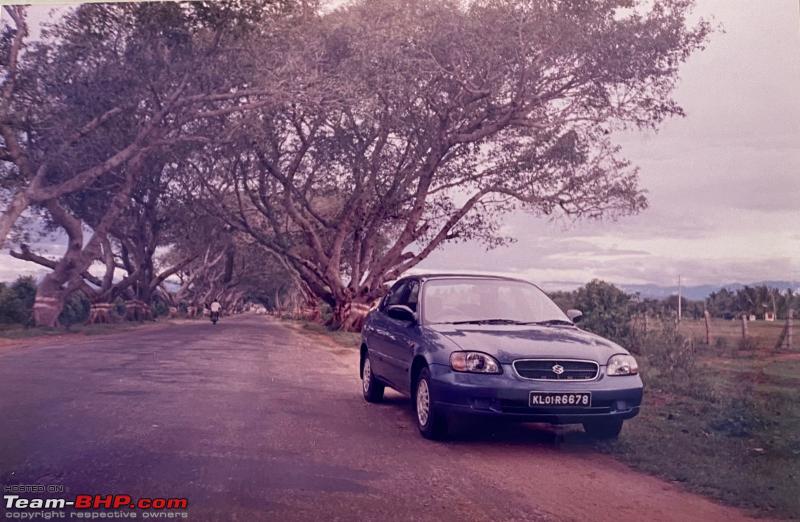

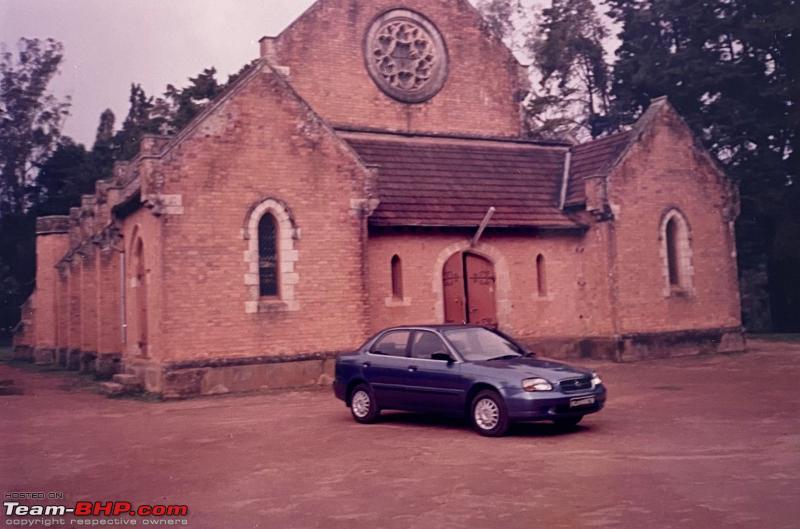

Check out BHPian comments for more insights and information.
News
Real world fuel economy of my Tata Altroz DCA after 2 years / 14,000 km
If you stay within these limitations, then it's a reliable workhorse from Tata Motors, similar to what the Swift or Wagon R is from Maruti. Fill it, shut it, forget it and go about your daily grind.
BHPian W.A.G.7 recently shared this with other enthusiasts:
Here's a random post on the Fuel Efficiency of the car. Note that these are "Highway" only mileages. We did a 220 kilometer round trip today morning and these are the fuel efficiency numbers that we got. I say, that's quite good for a 1.2NA engine mounted on a heavy car. I haven't used Fuelio or any other app. I just relied on the dashboard readings. The city mileage is always hovering between 10-12 kmpl depending on how dense the traffic conditions are. The point here to note is that these are not exceptional numbers, so if someone is expecting a diesel Altroz like fuel efficiency from the petrol motor, then it's not going to happen. In fact, this is not an exceptional car in that sense. It's a no-nonsense car, and will take you from Point A to Point B with the convenience of a proper automatic. If you stay within these limitations, then it's a reliable workhorse from Tata Motors, similar to what the Swift or Wagon R is from Maruti. Fill it, shut it, forget it and go about your daily grind. This is what the car is designed for and does really well.
While going...
While coming back...
Overall efficiency for the entire trip
Check out BHPian comments for more insights and information.
News
Living with the BMW M340i LCI2: 1,300 km Initial Impressions
Driving position is simply superb. You sit low and the seats and steering have good amount of travel for getting that perfect driving position.
BHPian Santoshbhat recently shared this with other enthusiasts:
I have completed about 1,300 kms on my new M340i LCI2 and here are some initial observations. It has been a mix of about 200 kms in the city and about 1,100 kms on the highway (4 lane expressway) so far. For context I own a stock 2016 F25 X3 30d , with adaptive suspension 19â staggered tubeless Michelins on aftermarket rims. Also had a Polo GTI for about 7 years, which was sold recently.
Â
- The car is very well built inside out. The doors close with a solid thud and everything feels solidly built. No cost cutting or thinning of metal here. The new design AC vents look and feel indestructible! The new flat bottom steering oozes quality and feels good to hold. The steering geometry has been tweaked slightly for the LCI2 update. It is a bit lighter to operate now compared to the pre update, but delivers good feedback nonetheless.
Â
- Driving position is simply superb. You sit low and the seats and steering have good amount of travel for getting that perfect driving position. Only issue I seem to be having is with the width of the sport seatâs backrest. The side bolsters are adjustable. You can adjust them to hug your body. I have a broad frame and find those side bolsters to be somewhat bothersome. Wish I could open them a bit more than the 'zero' position. My X3 too has sport seats with adjustable bolsters, but they are a bit wider.
Â
- The adaptive suspension has really added a whole new dimension to this car. The ride in comfort mode is now comfortable enough for you to be able to easily use this car as a normal car for regular use. You donât have to feel guilty about punishing your family when you are taking them in this car. The ride is plush, the sound insulation is superb and the Harmon Kardon system is pretty good (much better sounding than the HK system in the 2016 X3). With the âiconic soundsâ option turned off and a relaxed driver, no one will realise that they are in one of the sportiest and fastest accelerating cars in the country.
Â
- Adaptive suspension has not made the car a boat or a luxury limousine! It is still an M340i that is as sharp to drive as always. The handling is impeccable and there is always a tremendous sense of control and composure with the car staying flat and communicative. The change in sports mode is subtle and not drastic as far as the suspension tightening is concerned. The car leans less in sports mode and your bottom starts feeling the imperfections on the road a bit more. The ride is still not what you would call âuncomfortableâ. For the keen driver, sports mode is very engaging at higher speeds. There is almost zero body roll and the suspension keeps the car flat.
Â
- The car comes with 19â low profile Pirelli P Zero run flats. The M340i has lesser suspension travel and is visibly lower than other G20 versions. With lesser suspension travel and low pro 19â RFTs , youâd imagine the ride to be quite stiff and uncomfortable. I thought Iâd have to switch to tubeless very soon. On the contrary the ride is so good, that I donât feel any need to switch to tubeless at all. I may still have to, since I do believe these RFTs will be prone to damage on our roads.
Â
- I am not much of tech lover and generally not a fan of the new touch screen systems. While I am not a fan of the digital instrument cluster with the weird inverted tachometer (prefer the old analog type clusters), the curved infotainment display with iDrive 8.5 seems to be really well designed with lot of information available and customizable options. I am quite enjoying the new (new to me) connected car features like Android Auto, real time traffic alerts, augmented reality navigation, smart phone integration for unlocking, remote view, car data delivered on phone app etcâŠ
Â
- I love BMWs for the selectable drive modes and individually configurable options for suspension, steering, drive train, transmission, traction, exhaust note etc⊠In typical BMW style, you can play around with different permutations and configurations so as to precisely set up the car to suit the conditions and your mood. I really wish they gave us shortcut buttons for individually configurable drive modes, like they give in their proper M cars. There is a sport individual mode where you get to configure and save the settings. I want more individual setting shortcuts. These changes materially alter the way the car drives and feels. It can go from a comfy luxury cruiser to a raucous monster at the flick of a switch. It is like you have multiple cars at your disposal. In addition to the drive modes, the transmission has its own sport mode. In this mode the shifts not only happen at higher rpms but also the shift times are shorter, almost DCT like. I used this mode briefly while passing some two lane sections of the highway and it makes for a superb overtaking weapon. This mode should be great fun while driving up ghat roads in combination with paddle shifters! Speaking of shifting, I really wish they had not ditched their beautiful gear levers. That toggle switch like gear shifter is just sad.
Â
- The car comes with M sport exhaust as standard. In comfort note, the flap inside the right side exhaust outlet remains shut. There is only a faint exhaust note heard inside which is in sync with engine rpm and it is almost entirely piped in through the speakers. You can turn it off by turning off âiconic soundsâ option in the drive settings menu. In Sports mode the flap which remained shut in comfort mode, now opens and you get a deeper real exhaust note. It gets louder inside as well with more piped in sound. In Sport Plus you get plenty of burbles and pops in addition. I thought âiconic soundsâ option only switched on or off the fake sound that is played through the speakers and it does nothing to the actual exhaust outside. I was wrong! When in sport mode, the flap opens for a louder note. But if you turn off âiconic soundsâ at this point, the flap closes again. How do I know? I bent down on my knees and observed the flap opening and shutting when the option is turned off or on from the menu. This is another great option to have. If you want a quiet drive with family or doing a highway drive with elders, you can turn off iconic sounds and enjoy a quiet drive. Turn it back on when it is time for thrills! I have consciously stayed below 4,500 rpm for the run in period, with only occasional sprints to 5,000 rpm. It sounds great when revved. At the same time there is fantastic refinement at lower rpms.
Â
- I frequently drive to Belgaum on work and have been doing these drives for more than one and a half decades now. I have been doing these drives in my diesel powered X3 30d till recently. The 3 litre N57 engine is a real gem. The power and refinement of this engine is just tailormade for these long 500km expressway runs. I did a maiden run with the M340i and immediately realised that both engines have very different power and torque curves. With the X3 , you are almost always in peak torque range at anything over 100 kmph. The 8 speed ZF does a great job in presenting the right gear always. Just a slight tap on the A pedal and torque is delivered in dollops. With the petrol powered B58, you naturally need to rev it out a little more to reach that peak power band. I was able to see in the sport displays that I was nowhere near peak torque or peak BHP with the M340i, whereas in the X3, it was easy to see the peak 560nm and 240 ~ 250bhp being displayed quite often. I feel the real magic starts from 4,000 RPM with the B58. While I havenât gone close to the red line yet to due to run in restrictions, I did a few bursts upto 5,000 RPM or so and the acceleration is indeed quite brutal.
Â
- I usually get around 11.00 to 12.00 kmpl on my drives to Belgaum on the X3. I always do a full tank at the start of the journey . Since the X3 has a 70L tank, range was never an issue. With the 340, I had some range anxiety since the computer was showing 9 kmpl by the midpoint of the trip. If I went at the same pace, I would need to refuel enroute, which I was not comfortable with. So I went easy on the throttle and even drove in eco pro for a while. I managed to extend the range and managed to make it to my destination with 50km of range still in the bank. Overall stats read 10 kmpl for the 500km journey. Not bad at all for the performance on offer. For reference, I used to get about 11.5 to 12 kmpl on the Polo GTI for the same trip. I hope after break in, the numbers will improve.
Â
- X drive AWD system on the X3 is rear biased, but in the M340i it feels even more so. Almost feels like a RWD car. The X3 is rock steady at high speeds, but the M340i is something else. It masks speeds like nobodyâs business. I must keep an eye on the speedometer!


Check out BHPian comments for more insights and information.
News
Driving my Tata Nexon EV from Goa to Mangalore: This car delivers!
I suspect this electric vehicle can do the same journey 15% more efficiently if I hypermilled.
BHPian mally2 recently shared this with other enthusiasts:
Travel update
South Goa - Mangalore
Started at 91% and drove until 14%. Charged at Jio 60 kW in Udupi for 15mins. Upped to 43% as that was enough to reach Mangalore with 20% spare per my estimate.
Reality - I reached with 18% spare. That means 103% more consumed for 370 km @ 132 wh/km.
I used sports mode a lot in Karnal Ghats and maintained 85-95 kmph speeds throughout. Resulting in an average speed of 53 kmph for the whole journey.
The charging speeds and efficiency when driving like a regular car is very impressive.
I avoided hypermilling just to mimic ice driving. I am very familiar with hypermilling, and I suspect this car can do the same journey 15% more efficiently if I hypermilled. But thatâs for my solo trips. Canât annoy my wife anymore.
This car delivers and does not disappoint. Also, I used the small frunk of the Nexon very effectively for the Goa to Mangalore stretch, if you know what I mean.
Stay tuned for Mangalore to Bangalore upward elevation.
Here are some stats:


Check out BHPian comments for more insights and information.
News
Every Rupee spent on my Thar Roxx AX5L mods: Full list with costs
I have completed all the updates and mods that I had planned for my Mahindra Thar Roxx. Now, I hope to keep the SUV for at least 5 years.
BHPian Catamaran recently shared this with other enthusiasts:
Mods and updates on my Thar Roxx AX5L 4x4 Auto
Today, I received the car after the alloys painting and dechroming of badges. All the 18" alloys, including the newly installed spare tyre alloy were painted in gun metal color.
The âThar Roxxâ and â4x4â badges were dechromed in matt black. Now I have completed all the updates and mods planned in my Roxx. Hope to keep the car for at least 5 years.
Below is the list of work done with prices
- Graphene coating â 28,000
- Sun film SOLARSHIELD Teal 70 front & Sable 50 on sides â 24,000
- Spare tyre steel wheel and cover replaced with original Roxx 18â alloy, including mounting bracket from Mahindra â 19,550
- Seat covers, covering the dirt-prone white leatherette seats, similar color and stitching from Wellfit â 15,725
- Replaced Mahindra original speakers and tweeters with Harmon infinity Speakers Component with tweeters in front + Coaxial on back (No amp or subwoofer, to avoid future warranty-related issues) â 17,240
- All 5 alloys painting in gunmetal, and badges in matt black â 15,500
- Tail light cover from Mahindra â 1,700
Total spending for above after delivery â 1,21,715
All above were done remotely, still have not seen the car in person after the mods.
Some pictures taken by the person who collected the car.







Check out BHPian comments for more insights and information.
News
Testing out new special pliers and prepping Alfa Romeo for annual drive
They are specially made to help you undo electrical connectors in cars. I have also installed the windbreaker on the Spider ahead of our road trip.
BHPian Jeroen recently shared this with other enthusiasts:
Earlier this week, I received three new pliers. I ordered them in the USA, and they were made in China. They are now used in the Netherlands!
They are specially made to help you undo electrical connectors as used on cars. Those of you who have ever tried to do an electrical connector in an engine bay will know how difficult it can be. Usually, you have to press in a little clip, whilst at the same time pulling at the connector. Often these connectors might not that easily accessible as well.


Works very well

I have also installed the windbreaker on the Spider once again. Itâs that time of the year. In a few days' time, we are going on our annual Spider drive to our friends Cees and Annelies and their B&B in Buxurulles, France. Mrs. D enjoys coming along in the Spider, but she prefers not to get too wind-swept. Hence, the windbreaker on these long journeys.

This year, Peter has made an interesting route. We meet up in the very South of the Netherlands. We overnight at a local B&B, eat at an Italian restaurant opposite the road and set off for Le Paradis early the next day. All small, windy, twisty roads!

Not quite sure, but this is likely to be the 6th- 7th time we are taking this annual trip with our Spider friends. This year, it will be four Spiders making the journey.
I still need to clean the Spider in the coming days. I always like to start off in a clean car at least.
I already cleaned out the boot. And found some tools (extenders) that I lost more than half a year ago. After working on the Jeep with spanner mate Peter, I could not find these extenders. I checked with Peter. Occasionally, our tools get mixed up. I spent several hours looking for them. In the end, I replaced them. But yesterday I found them. No idea how, but I found them inside a plastic carrier bag, tucked away in one of the boxes with parts I carry in the Spider boot.

So now I have some extra extenders.
Check out BHPian comments for more insights and information.
News
From a Mahindra XUV500 to a Toyota Fortuner: My car upgrade story
And if you are looking for butch looks, go-anywhere capability and long term reliability and of course service experience, go for Fortuner.
BHPian SteeringStar recently shared this with other enthusiasts:
We all get that typical itch to upgrade our cars once in a while, correct?
Mine is no different. And in my case, I decided to go with this upgrade without any strong reason to sell XUV5OO. Sounding strange? Read on for the full story

History:
My journey with the previous car, an XUV5OO, W10, AT, AWD, started in August 2016. I had been happily driving it for many years. The engine is a gem and the vehicle never failed in any of our trips. Being AWD, it saved us out in many tricky terrains, though I did not take it for any serious offroading sessions. There were few niggles, I would call it cosmetic and didn't bother much as I was in love with that car and its prowess.
My initial experience about this beast is documented here >> https://www.team-bhp.com/forum/test-...uv500-awd.html
Coming to my new buy, a Toyota Fortuner Diesel AT Sigma, is another dream come true moment. I couldn't buy this car back in 2016 due to budget constraints. And that aspiration kept on irking me once in a while. Though the price doesn't do any kind of justice to what we get in terms of features, the butch bold look always bowled me over.

Now, the trigger to buy occurred when I visited Japan on a short stint during April'24. Couple of times, I ended up travelling in Toyota cars and I somehow couldn't resist that urge to buy a Toyota car, and that too Fortuner, my long pending dream. So, that's it, as soon as I returned, I took a test drive and booked the car. Did not consider any other cars. The booking was made at Kairali Toyota, Kochi. The booking and delivery experience were smooth (May 2024). Full marks to Kairali Toyota.

Instead of explaining every feature of Fortuner, which many of our fellow BHPians had already done, I will focus more on the upgrade experience and features, XUV5OO Vs Fortuner, side by side.
1. The "Likes"
XUV5OO:
a. Imposing design
b. Reliable engine (clocked around 85000 Kms with zero issues)
c. Huge leg space in middle row seats
d. a complete package (7 seats, AT, AWD) for Rs. 20 lakh, back in 2016.
e. Value for money - sun-roof, TPMS, Hill-hold assist, Hill descent assist, Differential lock, ESP-off, Voice commands, leather seats, cooled center arm-rest etc.
FORTUNER:
a. Head turner every time on road; The latest model is much refined so it is not butch looking anymore, however, it still looks massive. Always brings a grin on to my face.
b. Ventilated front seats
c. JBL audio system; reasonable to my listening taste
d. Being sigma version, it is a go anywhere vehicle. You will feel lots of confidence while offroading.
e. Reasonable space to keep couple of cabin bags even with 3rd row seats up.

2. The "Dislikes"
XUV5OO:
a. The middle row seats are neither movable nor reclining adjustable.
b. Extremely less boot space with the 3rd row seats up.
c. Low ground clearance of 180mm. It is not a deal breaker, however I always felt less confidence while navigating bad roads.
d. It's a BS-IV, so not possible to take it to Delhi and may be some other cities too in the future.
FORTUNER:
a. No sunroof
b. No TPMS (need to purchase separately)
c. No 360 camera (need to purchase separately)
d. The AT Sigma comes with Bridgestone HT tires and not AT. And I missed to get it changed to AT immediately after purchase
3. Price
On-road price: Rs. 21 lakh of XUV5OO Vs Rs. 51 lakh of Fortuner. Both cars are miles apart in terms of price.
Even if I compare the prices based on same year, i.e., 2016, Fortuner (AT/4WD) was still ~15 lakhs pricier than XUV5OO.
So, to me, it was a heart's decision Vs brain's decision.
4. Design & Styling
Here, Fortuner clearly outperforms XUV5OO. However, I felt XUV5OO had its own charm and butchness. Its design grew on me over the years. I could sense an emotional connect getting built over the years plus I always felt 'high' every time I got behind the wheels.
5. Build Quality, Fit & Finish
Of course, Fortuner has much better build quality. The interiors are 100% rattle free and feels premium. The faux wood inserts as well as leather wraps are of excellent quality.

6. Wheels & Tyres
It is the R16 of XUV Vs R17 of Fortuner. Not much difference is what I felt. Both were Bridgestone brand.
7. Ground Clearance
180 mm of XUV Vs 210 mm of Fortuner - This make a big difference when you go for offroading. I took Fortuner to couple of offroading places with lots of large rocks and didn't face any problem.
8. Standard & Extended Warranty
I remember getting extended warranty up to 5 years for XUV5OO. And for Fortuner too, it is a total of 5 years warranty and I also purchased a maintenance package for 2 years (no cost during 1st and 2nd service / 20000km).
9. Maintenance
There were no significant workshop runs during my 8 year tenure with XUV5OO. All services were done on time, every 10k Kms. And I'm hoping Fortuner too will continue to perform well for years to come.
10. Safety
Both cars are pretty much similar with 6 air bags and all other gizmos related to safety.
While XUV5OO is NCAP rated-4, Fortuner is NCAP rated-5.
11. Cabin Design & Quality
Fortuner's all black cabin interior looks much much better than the XUV's version. From switches and controls perspective, both cars sport ergonomic consoles. Interestingly, Fortuner dash looks pretty outdated while comparing with the current set of cars across all brands. For e.g., no digital odometer/tachometer console, no digital switches on the center console except audio controls. Hopefully, the future model of Fortuner may get these things upgraded.

12. Space & Comfort
It's mixed bag here. W.r.t driver seat, both cars felt equally good. A difference I noticed is the seat heigh adjustment - the play seems to be low for Fortuner and I felt wanting little more upward push.
As mentioned earlier, in XUV, though there are loads of space for middle row passengers, there is no sliding plus reclining adjustment. This is present in Fortuner and hence my kids love Fortuner middle row seats compared to XUV. The reclining option helps relax and sometimes they even take a comfortable nap there.
13. Driving Position & Ergonomics
I felt both cars are equally good in this parameter.
14. Cabin Storage
Both cars consists of 2 storage bins in front of front-passenger seat (the top one is cooled for Fortuner). Also present is the storage box under arm rest (cooled for XUV). Every other storage bins are pretty much similar in both cars.
15. Air-Conditioning
I felt Fortuner A/C is much better and powerful than XUV. Especially the middle row blowers. I felt XUV ones were pretty weak.
16. Unique & Noteworthy Features
The tea-cup holder in Fortuner is a nice addition and it comes handy many times.
The motorized boot lid is a handy one. Though it may operate at a slow pace, from a safety perspective, slowness is good.
The Toyota mobile App is a responsive app. You can find the last known location of the car without installing additional gadget for this purpose.
17. Audio System & Sound Quality
In XUV5OO, it was bare bones and hence I ended up installing a sub-woofer. That dramatically improved the listening quality. However, in Fortuner, am sticking on to the stock system for now. The sound quality is normal and there is a lot of scope for improvement if you are an audiophile.
18. Rear Seat Comfort & Space
3rd row seats are cramped in both the cars. Only suited for kids. Nothing more to comment here.
19. Boot Space
Fortuner boots are much better compared to XUV when all 3 rows are up.

20. Driving
I felt it was more fun driving XUV as the accelerator is super responsive and gets you that adrenaline rush when needed. In Fortuner, we get 3 different modes - ECO, NORMAL and SPORT. My default mode is ECO and for that occasional adrenaline rush, I switch to SPORT mode. It is indeed the best mode for getting a super responsive throttle push. ECO drive is sedate. Am yet to try NORMAL mode.
21. Noise, Vibration & Harshness (NVH)
Fortuner wins here as the cabin is quiet (except for engine noise). In fact, engine noise is present in both cars. I felt XUV engine noise is more refined compared to the typical diesel clutter in Fortuner.
22. Mileage & Fuel economy
XUV - Around 12 km/l in cities and 14 km/l during highway runs.
Fortuner - The average stands at 12.5 km/l at 14k Kms.
23. Suspension and ride comfort
XUV suspension felt much better than Fortuner. That bumpy feeling is there in both cars. Fortuner, in addition, has a tough suspension which makes it not so dear on rough patches and pot holes. I had to reduce the tire pressure little bit to make the ride comfortable.
24. Handling & Dynamics
Both cars have got super handling in spite of higher center of gravity. Body roll is there in both the cars but no one in my family complained so far.

25. Steering
Similar steering responses in both the cars.
26. Braking
Excellent braking responses in both the cars.
Summary:
To conclude, both cars have their positives and negatives. If you are looking for value-for-money, loaded features, ADAS, digital displays etc., then go for XUV7OO. And if you are looking for butch looks, go-anywhere capability and long term reliability and of course service experience, go for Fortuner. Of course, budget also is a key deciding factor. Also, if possible, I suggest to wait for the next gen Fortuner, most likely a hybrid (even pricier though).

Thank you so much for patiently reading my thoughts and munching the pics
Hoping that my post will help folks planning for a similar upgrade.
Check out BHPian comments for more insights and information.
News
The Journey from FWD to 4WD: Welcome home, Toyota Hilux STD!
The Hilux is now home and became an inseparable member of my family. I never miss a single chance to look back to it after reaching the destination for the ONE LAST TIME, AGAIN !
BHPian Gendiesel recently shared this with other enthusiasts:
The journey to Toyota Hilux !
To give you a glimpse about my taste in driving, I owned XUV 700 (FWD) since the end of BS4 era. At the beginning, I mostly enjoyed my first car experience over wide plains roads of Punjab, Haryana and Chandigarh, under the scanner of hawkâs eye of the traffic police, mostly during for official purposes. Later over time, when it came to leisure or adventurous drives, my heart and my car both always directed me to one place - Himachal.
Over a period, I developed a taste of taking de-tours, though longer and sometimes approaching nowhere, in the mountainous region from the usual NH/ SH. There were two primary reasons for taking such risks, first, I always feel safe inspite of being non-domicile, and second, each such time it opened a hidden natural treasure to my soul. So, it was quite frequent to experience the drive over muddy terrain during monsoon in and around Manali, upright elevations of Dhaula-Dhar ranges, stony undulations of Lahaul & Spiti and, snowy roads (I wonât say off-roads) in and around Kinnaur. These were terrains where I could push myself the most with my limited driving skills on a FWD car. There were occasions I stuck my car in mud as well as in snow, even at midnights, when local kind hearted people of Himachal came to the rescue and made me realized of my ill-preparedness and limited capabilities.
It was now the beginning of summers in Aprâ22 and I recently shifted to Hyderabad on my transfer after spending almost 4 years in Chandigarh. So, not just the temperature which changed here but an entirety of culture, tastes of people, way of traffic, and, so, the choices of car and the character of drive-destinations.
In Hyderabad, the adventure drives came to almost grinding halt lacking the taste I developed over the last few years. So, I started focusing more on gaining some knowledge in Automobiles. Post 2020 Covid-19 time, there have been surge of new influences and enthusiasts among the social media fraternity. Eventually, I was caught with a deep interest in off-road adventures, so, in 4WD cars. Since, I owned and mostly drove the diesel cars, I could never shift my taste in petrol. Diesel perhaps gave me the freedom and character where I found peace to my little driving enthusiasm.
It was now the end of 2023 and beginning of 2024 when there came a serious hunger to upgrade my existing car as it was now completing 5 years â increasing maintenance cost and decent resale value were in my mind.
Among 4WD cars, there were limited options like mighty Mahindra Thar (3 doors), Isuzu D-max V cross â a truck, newly launched Maruti Jimny and tough Force Gurkha (2021), as my budget corresponded. I was in no way looking for 2nd hand cars, so, the possibility of premium used 4WD cars I had in mind, was none.
Thar 3 door was a serious off-roader, reckoned among the off-roadering community, but, for me, it lacked in one undeniable psychological sense â the Character. Nevertheless, it was so well deigned and empowered to handle its native terrains - the off-roads - it lost its uniqueness over the period because of ignorant enthusiasts using it for attention-seeking-purposes. Functionally speaking, there were 3 factors where it performed poor compared to the competition viz. uncomfortable entry/ exit and tight spaces in rear seats, firstly, almost no storage space without costing seating space, secondly, and, horrible drive comfort with stock suspensions, thirdly. The new Thar (5 door) was in news that time and its imminent launch on the independence day of 2024. Ample of news were spreading around full of expectations about new Thar (Roxx) for its upgrade with respect to most of the points of my concern and even beyond. Though I was also eager to see the new Thar, but at the back of the mind, I lost my hope with Thar for the very psychological reason.
Isuzu D-max V cross, the truck, was one of the options, though over-priced. This, longer wheel base vehicle, lacked in three senses, first, looked and felt so outdated while no certainty over any facelift in near future,, second, the limited-service facilities and, third, lacking the differential lock.
The new Jimny was exclusively launched in petrol, so, was dropped for the very reason in my consideration.
Force Gurkha 2021 got its unique fan-following and a limited, but dedicated, enthusiast community caught my attention, though with its limitations on important fronts â 91 bhp engine, limited articulation, low lying lower-control-arms, poor age-old interior, and the reliability. But there were reasons for me to explore the Gurkha more for its distinct potentials viz. rugged built, the ergonomics and the driving comfort, the panoramic view and, most importantly, the character â which brought up the Gurkha in my eyes against the Thar for very reason. In the meantime, Gurkha 2024 was launched in early 2024 eliminating most of the points of concerns except the interiors which still was almost unchanged, to my shock.
But later on, there were stories of frustrated Gurkha owners who were struggling in their experience with this behemoth due to unforeseen and frequnt breakdowns. The ownersâ dissatisfaction on service response, the petty oil leakages, seal issues, gear shifting issues, unreliable DPF are enough reasons, after someone spending 20+ lakhs, to question the sanctity of the 2024 facelift. It was very much understandable that not everyone can spend their entire day at the service center by choice. Our country, fortunately or unfortunately, still lacks the culture of self-maintenance. Enthusiasts and experts may find these breakdowns as opportunities, a FUN to cherish and a REASON to feel satisfied by knowing their car a bit more. But this might be a painful story for the rest of the community.
This was when for the first time, Toyota Hilux was in the boom among the social media influencers with a buzz of discounts. I started studying and did my maths to understand its feasibility.
After learning and test driving the Hilux, it gave me the sense of ânew characterâ entirely. It was a diesel, torquey combination of engine and transmission, Toyotaâs reliability, comfort (compared to Thar and my XUV 500), respectable interiors amongst others. Nothing additional to mention, about its capabilities, but it almost ticked on all check points.
So, it was almost now the end of 2024, and I was certain to change my XUV 500 with either of Force Gurkha or Toyota Hilux (STD) â the price difference was not much â for some unavoidable reasons:
1. My old carâs (XUV 500) rising maintenance cost
2. Lower resale value with each delay in selling (already crossed 5 years)
3. Govt policies against Diesel (news on uncertainties associated with this beloved fuel in passenger car segment like hiked taxation)
4. Upcoming BS7 norms â more complications in the new-gen diesel cars, so, its reliability and elevated costs - as we saw during shift to BS6.
5. Possibly last Diesel car purchase for me, for above last two reasons, with an eventual compelled shift to greener cars.
So, here I took the decision and went ahead with Toyota Hilux (STD) which satisfied me reliving me from the points of concerns:
1. The king-like-character of the DIESEL truck
2. Toyotaâs reliability â engine or transmission or chassis! I can peacefully keep this indestructible vehicle for years to come.
3. Toyota service experience and the maintenance cost
4. The price point at which it was offered at the time of purchase
5. Full 5 seating space and additional carrier space
6. Numerous ways of customization opening a new dimension of overlanding
The Hilux is now home and became an inseparable member of my family. Be it at any time of the 24 hours, the passion it gives me while lifting the key to take it out is evergreen. Every single time, I unlock the car and grab the handle to get inside raises my adrenaline like climbing to sit on the throne. Lastly, I never miss a single chance to look back to it after reaching the destination for the ONE LAST TIME, AGAIN !
Lot of text is written, so, here are some photographs to the hungry eyes:



Check out BHPian comments for more insights and information.
News
From day one to 40000 km: Phenomenal Tata service experience in Kolkata
Their commitment to customer satisfaction, timely service, and honest pricing has kept me confident in my Tata Harrierâs upkeep so far.
BHPian MotoKind27 recently shared this with other enthusiasts:
Tata Lexus Motors Nalmuri Service Center (Kolkata) â 40,000 km Service Experience with the Harrier
Hello Team-BHPians,
I wanted to take a moment to share my service experience with Tata Lexus Motors Nalmuri Service Center, Kolkata, after clocking over 40,000 km on my Tata Harrier. Having experienced the ups and downs that come with owning and maintaining a car over this distance, I can confidently say that Lexus Motors has played a big role in keeping things smooth.
- Vehicle: Tata Harrier
- KM Covered: 40,000+
Service Experience â Honest and Efficient
From the very first service, Lexus Motors has maintained a high level of professionalism. Their staff is approachable, knowledgeable, and always willing to listen. Iâve interacted with the same service advisor for most of my visits, which helps a lot in terms of familiarity and trust.
- Transparency: One of the highlights of my experience has been their transparent approach to service. No hidden charges, no unnecessary upselling. I always receive a clear job card with expected costs before the work begins, and the final bill has never had any surprises.
- Cost: Service costs have been very reasonable so far. Even at the 40,000 km mark, I havenât felt like Iâm paying a premium. They follow Tataâs standard service schedule closely, which keeps things predictable.
- Timeliness: This is where Lexus Motors really shines. Whether itâs a routine service or something more urgent, they have always stuck to the promised timelines. In fact, on a couple of occasions when I had travel plans, they even managed to fast-track the work and hand over the vehicle earlier than expected.
- Upgraded Facility: Recently, the service centre has undergone a noticeable upgrade in line with Tata Motorsâ new standards. The waiting lounge is cleaner and more comfortable, the service bays look better organized, and the overall workflow seems much more streamlined. You can tell theyâve invested in improving the customer experience.
What Could Improve?
Not much to complain about, honestly. But if I had to nitpick, the service centre does get quite busy during weekends, so itâs better to book your slot in advance. A mobile app-based service status tracker would also be a welcome addition for better transparency during the service process.
Final Verdict:
If youâre a Tata owner in or around Kolkata, Iâd highly recommend Tata Lexus Motors for both routine maintenance and unexpected repairs. Their commitment to customer satisfaction, timely service, and honest pricing has kept me confident in my Harrierâs upkeep, and I look forward to the next 40,000 km and beyond.
Check out BHPian comments for more insights and information.
Pages







